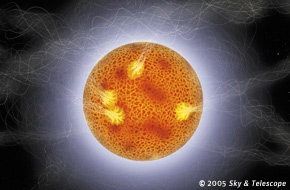For most of this past semester, I drilled students on the differences between the two main types of supernova — for example, pointing out (counterintuitively) that Type I blasts require two stars, whereas Type IIs involve just one.

Two of four unusually bright, blue supernovae discovered in 2009 and 2010 by the Palomar Transient Factory sky survey.
R. Quimby & others / PTF / Nature
Now I'm going to have to rework the syllabus, and it's all the fault of Caltech astronomer Robert Quimby. Hired a few years ago to help run a sky survey called the Palomar Transient Factory, Quimby soon turned up three unusual supernovae in 2009 and a fourth in 2010 that just didn't fit the two well-established types.
For one thing, these four were 10 times brighter than most other exploding stars, and they took a relatively long time (1½ months) to fade. But, most curiously, their spectra were strongly blue and showed no sign of hydrogen — a common elemental fingerprint in such blasts. Most curious, indeed!
Then Quimby realized that the oddball spectra matched up well with those of two other unusual supernova that had defied explanation: SN 2005ap, which he and others had spotted several years ago; and SCP 06F6, identified in 2006 with the Hubble Space Telescope. All six were quite distant — after a little redshift adjustment, Quimby realized that 2005ap was about 3 billion light-years away, SCP 06F6 was 8 billion light-years away, and the four PTF finds had exploded somewhere in between.
So the six appear to be alike, but how? "We have a whole new class of objects that can't be explained by any of the models we've seen before," Quimby admits in a Caltech press release. The brilliant blasts are quite hot (10,000 to 20,000 Kelvins) and are expanding outward at some 6,000 miles (10,000 km) per second.
Beyond these few factual scraps, they're a mystery. "These supernovae are rare, very luminous, and probably not powered by radioactive elements in the way Type Ia and Type II are," comments Robert Kirshner, a supernova specialist at the Harvard-Smithsonian Center for Astrophysics.

This illustration, based on the latest scientific thinking, represents how a magnetar might appear if we could view it up close with X-ray vision. But this is not something anyone would want to do. Magnetars are neutron stars with magnetic fields so extraordinarily powerful that they could kill a person from 600 miles (1,000 km) away by warping the atoms in living flesh.
One possible explanation is that behemoth stars, 90 to 130 Suns in mass, throw off hydrogen-free outer layers prior to self-destructing and heating up those shells. Another notion is that each supernova leaves behind a magnetar, a superdense, rapidly spinning, and strongly magnetized object. Interactions of the magnetar's rotating field with charged particles around it could create enough energy to heat up shells of matter blown into space by the supernova explosion.
"The idea that these might be the formation of magnetars is pretty interesting," Kirshner notes. "My own guess is that this has more to do with the last stages of stellar evolution, when burps of gas outside the star get whacked by the [supernova's] expanding shell."
In any case, he concludes, "Quimby should get a lot of credit for recognizing that he had something odd, and puzzling out what it might be." Quimby and his collaborators published their observations in the June 8th online edition of Nature.
 4
4
Comments
Justin
June 16, 2011 at 12:45 pm
I note that the bright object to the right of the "supernova" in the left hand image seems to move. Does anyone know what that object is?
You must be logged in to post a comment.
john
June 17, 2011 at 12:01 am
what direction in the night was this can some tell me
You must be logged in to post a comment.
Stan
June 17, 2011 at 3:29 pm
I assume you are refering to the orange star. This is a star with a proper motion that is large enough to be seen after even a few years. Stars such as this come up often when blinking while searching for supernovae. This particular star is PPMX 161208.5+512850.
You must be logged in to post a comment.
Justin
June 18, 2011 at 5:25 am
Thanks for the info on PPMX 161208.5+512850!
You must be logged in to post a comment.
You must be logged in to post a comment.